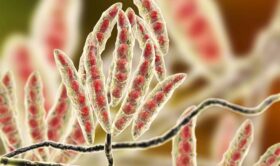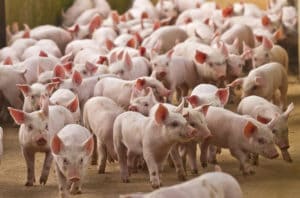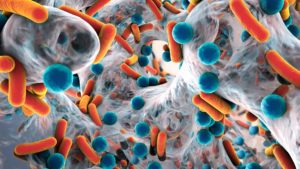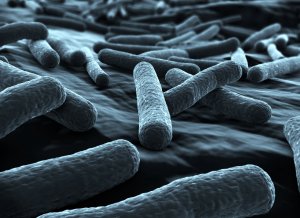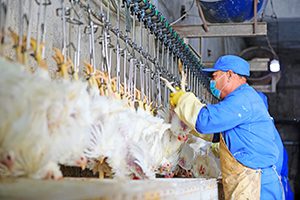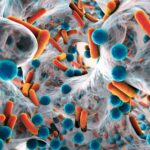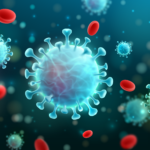SARS-CoV-2 is causing one of the worst global challenges in the 21st century right now. The virus is a member of the family of coronaviridae and belongs to the RNA-viruses. It is assumed that the virus was transmitted by wild animals on a wet market in China. If the virus came from wild animals, is it possible that it can also be transmitted to our farm animals and vice versa? There is considerable confusion in the market. In India, e.g., sales of poultry meat broke down by 80% since January, due to rumors that one could catch the virus from eating chicken.
Corona – nothing new in agriculture!
For people working in the agricultural sector, coronaviruses are not unknown. Cattle producers often fight against diarrhea in newborn calves and against winter dysentery in young adult cattle. Pig farmers know Porcine Epidemic Diarrhoea (PED) and Transmissible Gastroenteritis (TGE) very well. Poultry farmers vaccinate their animals against infectious bronchitis (IB). Are these diseases all caused by the same viruses? No! Different members of the coronavirus family are responsible.
Most of the coronaviruses are species – and tissue – specific
To infect animals or humans, the spike-proteins forming the crown – the “corona” – of the coronavirus must bind to receptor molecules on the target cells of the host’s tissues. The binding is highly specific, just like a lock and its specific key go together, or how an antibody binds to a particular pathogen. SARS-CoV-2, for example, needs a particular cell membrane protein (angiotensin-converting enzyme 2 – ACE2) to enter human cells; TGE viruses, on the other hand, depend on the porcine aminopeptidase N (ANPEP). The cells of pigs have other receptor molecules than the cells of poultry. The cells of the gastrointestinal tract are different from the cells of the respiratory tract (Russ, 2020).
Table: examples for the different coronaviruses in livestock and humans (adapted from Ackermann, 2016 )
| Virus | Disease | Species | Genus* |
| TGEV
PEDV FCoV-I |
Transmissible gastroenteritis
Porcine epidemic diarrhea Feline infectious peritonitis (FIP) |
Pigs
Pigs Cats |
α |
| BCoV
HEV MERS-CoV SARS-CoV SARS-CoV-2 |
Diarrhea in newborn calves; winter dysentery
Vomiting and wasting disease Middle East respiratory syndrome Severe acute respiratory syndrome COVID-19 |
Cattle
Pigs Humans Humans Humans |
β |
| IBV
TCV |
Infectious bronchitis
Blue comb disease |
Poultry
Poultry |
γ |
| PDCoV | Porcine delta coronavirus | Pigs | δ |
*for the allocation to the genus, one crucial factor is the viral protein nsp 1.
Corona in Pigs
For pigs, five coronaviruses are relevant. The porcine epizootic diarrhea virus (PEDV) and the transmissible gastroenteritis virus (TGEV) belong to the α genus. They show a high affinity to the epithelial cells of the gastrointestinal tract. The porcine respiratory coronavirus (PRCV) is also a representative of the α genus, but does not show any affinity to the gastrointestinal epithelial cells. It causes respiratory diseases. The other viruses are the hemagglutinating encephalomyelitis virus responsible for the vomiting and wasting disease and belonging to the β-genus, and the porcine delta coronavirus (PDCoV), causing diarrhea (Stiebnitz, 2017).
Corona in Poultry
Infectious bronchitis caused by a coronavirus belonging to the γ genus is one of the major economically critical respiratory diseases in poultry. As it also affects the kidney and the reproductive tract, the consequences are kidney damage, decreased egg production, and bad egg quality. A further significant problem of IB in poultry is the rapid spread. Within 48 hours, a whole flock can be infected and remains a virus reservoir, even after recovery. Usually, the infection is horizontal, from hen to hen, not from hen to the chick. However, infection via contaminated eggs shell in the hatcheries is also possible (MacLachlan and Dubovi, 2016).
Corona in cattle
The symptoms associated with bovine coronaviruses are calf diarrhea, winter dysentery (hemorrhagic diarrhea) in adult cattle, and respiratory infections in animals of various ages (MacLachlan and Dubovi, 2016). The bovine coronavirus belongs to the ß genus. The bovine coronavirus is not as host-specific as many other coronaviruses. It can infect dogs, turkeys, and other wild ruminants such as waterbucks, giraffes, or white-tailed deers.
Can SARS-CoV-2 also be exchanged between humans and livestock?
SARS-CoV-2, like the MERS-CoV (Middle East Respiratory Syndrome) and the SARS-CoV (2002/03), belongs to the ß genus of coronaviruses. All three can infect animals and humans, which can be seen from the way they spread: SARS-CoV originated from bats, MERS-CoV was transmitted by camels, and for SARS-CoV-2, bats (Zhou et al., 2020) but also pangolins (Zhang, 2020) are assumed to be the source. But not livestock animals.
There is one known case of a SARS-CoV infected pig, which was discovered in China in the context of research on the SARS epidemy in 2002 (Chen, 2005). Scientists from the Chinese Academy of Sciences in Beijing examined six animal species living in close contact with humans and found this one pig infected by SARS-CoV of human origin. As the only person having contact with the pig was tested negative for the coronavirus several times, it was concluded that the infection likely came from virus-contaminated feed. The pigs in rural areas in China are often fed the leftovers from restaurants.
For now: keep calm
Today, there is no scientific indication that livestock can contract SARS-CoV-2 from humans or vice versa. In Germany, the Friedrich Löffler Institute (2020), a leading research institute on epizootic diseases, is conducting extensive studies at the moment to better understand the sensitivity of animals towards SARS-CoV-2. Reliable results are expected earliest at the end of April. Until then, let’s keep calm, and behave responsibly to weather these unsettling times.
By Inge Heinzl, Editor EW Nutrition
References:
Ackermann, Matthias. “Taxonomie und Familienalbum der Viren.“ Beilagen zur Vorlesung Virologie 2015/16 Teil II (2016). https://www.vetvir.uzh.ch/dam/jcr:b55d076d-f488-47c7-87b3-774f9d05c0f2/Vi_Fam2016%281%29.pdf
Chen, W., M. Yan, L. Yang, B. Ding, B. He, Y. Wang, X. Liu, C. Liu, H. Zhu, B. You, S. Huang, J. Zhang, F. Mu, Z. Xiang, X. Feng, J. Wen, J. Fang, J. Yu, H. Yang and J. Wang. „SARS-associated coronavirus transmitted from human to pig.“ Emerg. Infect Dis. 11 no. 3 (2005): 446-8. https://doi.org/10.3201/eid1103.040824
Daly, Russ. “COVID-19 and Livestock: Is there a connection?.” Swineweb (2020). http://www.swineweb.com/covid-19-and-livestock-is-there-a-connection-by-russ-daly-professor-sdsu-extension-veterinarian-state-public-health-veterinarian/
Friedrich Löffler Institut. SARS-CoV-2 / COVID-19: Umgang mit Haus- und Nutztieren. Short Messages. 02/28/2020. https://www.fli.de/en/news/short-messages/short-message/sars-cov-2-covid-19-umgang-mit-haus-und-nutztieren/
MacLachlan, N. James and Edward J. Dubovi (Eds.). „Coronaviridae.” Fenner’s Veterinary Virology (Fifth Edition, 2016). Academic Press. Copyright: Elsevier Inc. https://doi.org/10.1016/C2013-0-06921-6
Stiebnitz, Christoph Gunther. „Charakterisierung und klinische Verlaufsuntersuchung aktueller PEDV-Feldinfektionen in deutschen Schweinebeständen unter Berücksichtigung betriebsspezifischer Managementfaktoren“. Inaugural Dissertation, München, 2017. urn:nbn:de:bvb:19-208698. https://edoc.ub.uni-muenchen.de/20869/1/Stiebritz_Christoph.pdf
WHO. “Middle East respiratory syndrome coronavirus (MERS-CoV).” Factsheets. WHO (2019). https://www.who.int/news-room/fact-sheets/detail/middle-east-respiratory-syndrome-coronavirus-(mers-cov)
Zhang, Tao, Qunfu Wu and Zhigang Zhang. “Probable Pangolin Origin of SARS-CoV-2 associated with the COVID-19 Outbreak.” Current Biology 30 (2020):1-6. https://doi.org/10.1016/j.cub.2020.03.022
Zhou, Peng, Xing-Lou Yang, Xian-Guang Wang, Ben Hu, Lei Zhang, Wei Zhang, Hao-Rui Si, Yan Zhu, Bei Li, Chao-Lin Huang, Hui-Dong Chen, Jing Chen, Yun Luo, Hua Guo, Ren-Di Jiang, Mei-Qin Liu, Ying Chen, Xu-Rui Shen, Xi Wang, Xiao-Shuang Zheng, Kai Zhao, Quan-Jiao Chen, Fei Deng, Lin-Lin Liu, Bing Yan, Fa-Xian Zhan, Yan-Yi Wang, Geng-Fu Xiao and Zheng-Li Shi. “A pneumonia outbreak associated with a new coronavirus of probable bat origin.” Nature 579 (2020):270-273 https://doi.org/10.1038/s41586-020-2012-7


